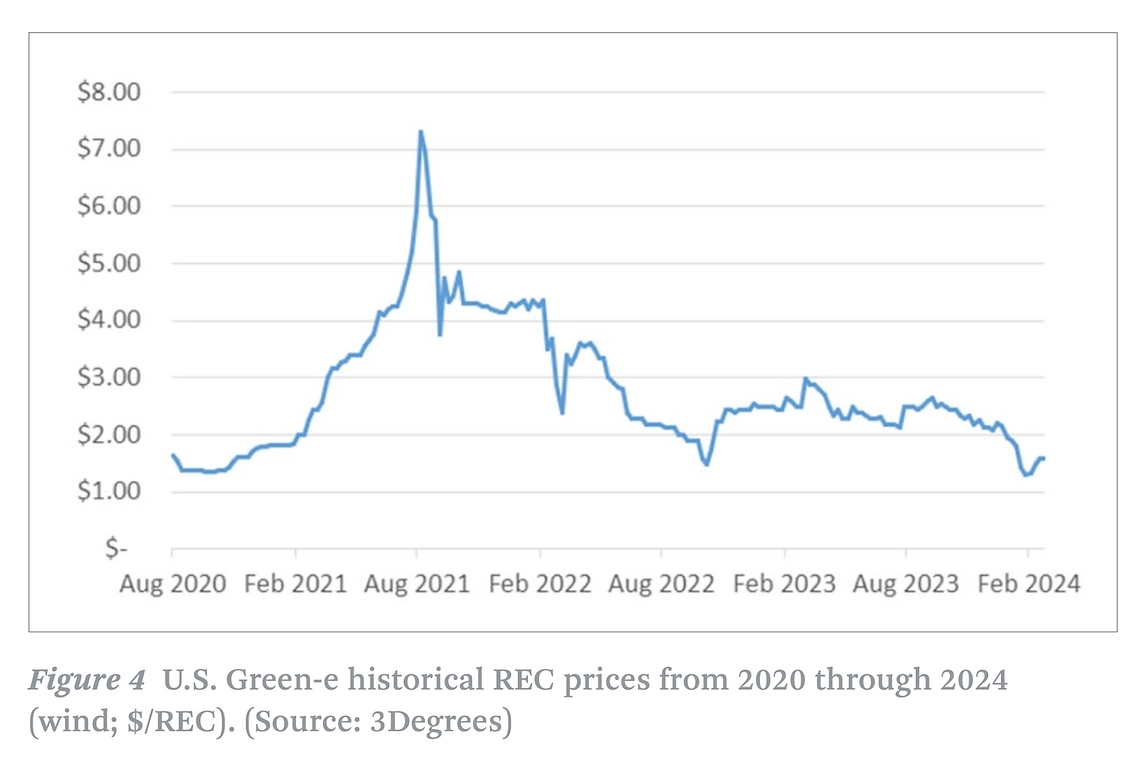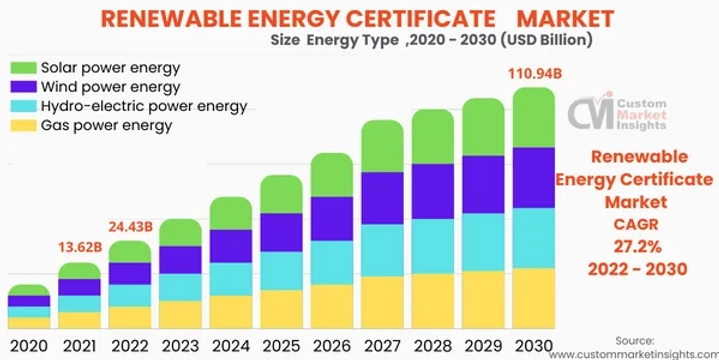In the dynamic landscape of renewable energy, one term that frequently surfaces is Renewable Energy Credits (RECs). These credits play a pivotal role in the integration of clean energy into the grid, incentivising renewable energy production, and facilitating environmental sustainability efforts.
Let's delve into what RECs are, how they function in the US market, their pricing evolution, and the current state of the REC market.
What are Renewable Energy Certificates (RECs)?
RECs represent the environmental attributes of renewable energy generation. When renewable energy is produced, such as solar or wind power, two distinct products emerge: the electricity itself and the associated environmental benefits. RECs quantify and track these benefits, serving as a mechanism to validate and incentivise renewable energy generation.
How do RECs work?
When a renewable energy generator produces electricity, it can choose to sell both the electricity and the associated RECs separately. The electricity is typically sold into the wholesale power market, while the RECs are sold to entities seeking to meet renewable energy targets or demonstrate environmental stewardship. By purchasing RECs, buyers effectively support renewable energy generation and offset their carbon footprint.
US REC market growth
The US REC market has witnessed significant growth in recent years, fuelled by increasing awareness of climate change and the transition towards clean energy. States with Renewable Portfolio Standards (RPS) or similar policies mandate utilities to procure a certain percentage of their electricity from renewable sources. RECs play a vital role in compliance with these standards, driving demand in the market.
As of 2021, the Renewable Energy Credit (REC) market stood as a formidable force, boasting a staggering $11.45 billion valuation. Notably, the compliance market constituted a lion's share, commanding a remarkable 95% of this value. However, this is merely the beginning of a grand narrative poised for exponential growth.

Unbundled REC prices have surged back to levels reminiscent of 2020, marking a notable resurgence in the market. Yet, forecasting long-term supply and demand dynamics remains a formidable challenge due to the voluntary nature of the unbundled REC market. Consequently, predicting sustained trends in REC prices proves to be a labyrinthine endeavour, fraught with uncertainty.
However, amidst this unpredictability, there are discernible signals pointing towards a potential upward trajectory in REC prices. Forward prices, which encapsulate future vintages currently being traded, indicate a notable uptick for subsequent years (2025-2026) compared to the current 2024 vintage. This suggests a prevailing sentiment among market participants that the price of RECs is poised for an ascent in the years ahead, reflecting underlying confidence in the future value of renewable energy credits.
According to the S&P Global Market Intelligence Power Forecast, the REC market is on a trajectory of unprecedented expansion, poised to more than double in value, reaching an impressive $26.5 billion by the dawn of 2030. While the compliance market continues to exert its dominance, a seismic shift awaits, with its share projected to diminish to 76% by the decade's end. This transformation signifies a burgeoning voluntary market, indicative of a collective commitment towards sustainability and environmental stewardship.
Within this landscape of evolution, distinct sectors emerge as beacons of progress. The solar carve-out, for instance, is forecasted to experience gradual yet substantial growth, ascending from $3.2 billion in 2022 to a commendable $3.6 billion by 2030. However, it is the offshore wind REC market that steals the spotlight, poised for an unprecedented surge from virtual obscurity to a commanding $3.6 billion stronghold by the close of the decade, propelled by robust REC prices and a fervent drive towards offshore wind projects.
Regionally, the West emerges as a towering figure, both in terms of renewable energy generation and market size. Surpassing its counterparts, the West is forecasted to soar to $9.1 billion by 2030, with tantalising prospects of surpassing $13 billion according to our optimistic scenario. PJM, the second-largest market, is not far behind, poised to nearly double its REC market from $2.8 billion to a formidable $5.3 billion. Meanwhile, New York ISO, ISO New England, and the Midcontinent ISO solidify the top five, each contributing significantly to the REC market's vibrant tapestry.
"However, amidst this transition, a striking juxtaposition emerges. Despite the ascendancy of voluntary initiatives, the allure of compliance remains resilient."
In essence, the REC market embodies a narrative of promise and potential, a testament to collective efforts towards a greener, more sustainable future. As it continues to burgeon and evolve, it serves as a beacon of hope, illuminating the path towards a world powered by renewable energy and fuelled by unwavering dedication to environmental harmony.
Unveiling future horizons: insights from S&P Global market intelligence
Harnessing the intricate dynamics of REC prices, S&P Global Market Intelligence embarked on a transformative journey to forecast the trajectory of the REC market through 2030. Termed as the "base case" in this comprehensive study, the forecast unveiled a compelling narrative of growth, painting a vivid picture of the U.S. REC market more than doubling in value from approximately $12.1 billion in 2023 to a formidable $26.5 billion by the dawn of the new decade.

However, the exploration didn't end there. In a quest for deeper understanding and insight, an additional scenario was meticulously crafted. This alternative perspective, dubbed the "upside case," relied on current REC prices across states and markets, augmented by a steady annual growth rate of 2.5%. The findings unveiled a tantalising vista, showcasing a REC market poised for even greater prosperity. With a valuation surpassing $17.1 billion in 2023, the "upside case" projected an ascent to nearly $33.8 billion by the culmination of 2030.
This dual-pronged approach illuminated the intricacies of REC market dynamics, offering stakeholders a nuanced understanding of potential trajectories and opportunities. As the REC market continues its evolution, guided by data-driven insights and strategic foresight, it emerges as a beacon of resilience and potential, poised to shape the future of renewable energy in the United States and beyond.
The case for Exponential growth
According to CMi Global, REC market size surpass US$ 110.94Bn by 2030.
The exponential growth projected for the Global Renewable Energy Certificate (REC) Market underscores a transformative shift towards sustainable energy practices worldwide. With an estimated value of USD 13.62 billion in 2021, the REC market stands as a beacon of progress in the quest for environmental sustainability. However, the journey towards a greener future is just beginning, as forecasts indicate a monumental leap to approximately USD 110.94 billion by the year 2030.

This astronomical growth trajectory, characterised by a remarkable Compound Annual Growth Rate (CAGR) of roughly 27.2% between 2022 and 2030, reflects a convergence of several pivotal factors driving the global transition towards renewable energy adoption.
First and foremost, heightened awareness of climate change and its far-reaching implications has spurred governments, corporations, and individuals alike to embrace renewable energy solutions as a means to mitigate carbon emissions and curb environmental degradation. Initiatives such as the Paris Agreement have galvanized international efforts towards decarbonisation, fuelling demand for RECs as a mechanism to validate and incentivise renewable energy generation.
Furthermore, advancements in renewable energy technologies, coupled with declining costs of production and installation, have rendered renewable energy sources increasingly competitive with traditional fossil fuels. This cost competitiveness has not only bolstered investment in renewable energy projects but has also expanded the accessibility of renewable energy options to a broader spectrum of consumers and businesses.
Additionally, regulatory frameworks and policy incentives at both the national and regional levels have played a pivotal role in driving the growth of the REC market. Renewable Portfolio Standards (RPS), Renewable Energy Targets (RETs), and carbon pricing mechanisms have provided a regulatory framework conducive to renewable energy development, stimulating investment and market expansion.
Moreover, the growing emphasis on corporate sustainability and ESG (Environmental, Social, and Governance) principles has propelled demand for RECs among businesses seeking to demonstrate their commitment to environmental stewardship and meet sustainability targets. This corporate demand, coupled with increasing consumer awareness and preference for eco-friendly products and services, has further fuelled the growth of the REC market.
In conclusion, the projected surge in the Global Renewable Energy Certificate Market reflects a paradigm shift towards a more sustainable and resilient energy future. As the world strives to address the pressing challenges of climate change and environmental degradation, RECs emerge as a critical tool in the transition towards a cleaner, greener, and more sustainable energy landscape.
Key takeaways
The seismic shift towards renewable energy sources is poised to propel the Renewable Energy Credit (REC) market to unprecedented heights, reaching a staggering $30 billion in the United States by 2030. While compliance remains the bedrock of the REC market, a notable paradigm shift is on the horizon.
In a remarkable turn of events, voluntary megawatt-hours are anticipated to surpass mandatory production as early as 2023, heralding a new era where voluntary initiatives take center stage. By 2026 and beyond, voluntary generation is projected to constitute more than two-thirds of total U.S. renewable generation, underscoring a monumental shift towards sustainability and environmental stewardship.
However, amidst this transition, a striking juxtaposition emerges. Despite the ascendancy of voluntary initiatives, the allure of compliance remains resilient. With voluntary REC prices notably lower than their compliance counterparts, the compliance dollar volume continues to exert substantial influence, accounting for between 76% and 84% of the overall U.S. REC market throughout the outlook period.
These key takeaways offer a compelling narrative of transformation and evolution within the REC market. As the energy landscape undergoes profound change, stakeholders are poised to navigate a dynamic terrain shaped by shifting market dynamics, regulatory imperatives, and a collective commitment towards a sustainable energy future.


.png)

